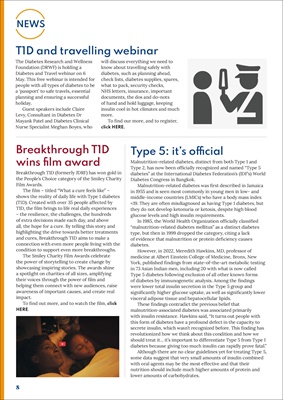
8
NEWS
T1D and travelling webinar
The Diabetes Research and Wellness
Foundation (DRWF) is holding a
Diabetes and Travel webinar on 6
May. This free webinar is intended for
people with all types of diabetes to be
a 'passport' to safe travels, essential
planning and ensuring a successful
holiday.
Guest speakers include Claire Levy,
Consultant in Diabetes Dr Mayank
Patel and Diabetes Clinical Nurse
Specialist Meghan Boyes, who will
discuss everything we need to know
about travelling safely with diabetes,
such as planning ahead, check lists,
diabetes supplies, spares, what to
pack, security checks, NHS letters,
insurance, important documents, the
dos and do-nots of hand and hold
luggage, keeping insulin cool in hot
climates and much more.
To find our more, and to register,
click HERE.
Breakthrough T1D
wins film award
Breakthrough T1D (formerly JDRF) has won gold in
the People's Choice category of the Smiley Charity
Film Awards.
The film - titled "What a cure feels like" - shows
the reality of daily life with Type 1 diabetes (T1D).
Created with over 35 people affected by T1D, the
film brings to life real daily experiences - the
resilience, the challenges, the hundreds of extra
decisions made each day, and above all, the hope
for a cure. By telling this story and highlighting
the drive towards better treatments and cures,
Breakthrough T1D aims to make a connection
with even more people living with the condition
to support even more breakthroughs.
The Smiley Charity Film Awards celebrate
the power of storytelling to create change by
showcasing inspiring stories. The awards shine
a spotlight on charities of all sizes, amplifying
their voices through the power of film and
helping them connect with new audiences, raise
awareness of important causes, and create real
impact.
To find out more, and to watch the film, click
HERE.
Type 5: it's official
Malnutrition-related diabetes, distinct from both Type 1 and
Type 2, has now been officially recognized and named "Type 5
diabetes" at the International Diabetes Federation's (IDF's) World
Diabetes Congress in Bangkok.
Malnutrition-related diabetes was first described in Jamaica
in 1955 and is seen most commonly in young men in low- and
middle-income countries (LMICs) who have a body mass index
<19. They are often misdiagnosed as having Type 1 diabetes, but
they do not develop ketonuria or ketosis, despite high blood
glucose levels and high insulin requirements.
In 1985, the World Health Organization officially classified
"malnutrition-related diabetes mellitus" as a distinct diabetes
type, but then in 1999 dropped the category, citing a lack
of evidence that malnutrition or protein deficiency causes
diabetes.
However, in 2022, Meredith Hawkins, MD, professor of medicine
at Albert Einstein College of Medicine, Bronx, New York,
published findings from state-of-the-art metabolic testing in 73
Asian Indian men, including 20 with what is now called Type 5
diabetes following exclusion of all other known forms of diabetes
by immunogenetic analysis. Among the findings were lower total
insulin secretion in the Type 5 group and significantly higher
glucose uptake, as well as significantly lower visceral adipose
tissue and hepatocellular lipids.
These findings contradict the previous belief that malnutritionassociated
diabetes was associated primarily with insulin
resistance. Hawkins said, "It turns out people with this form
of diabetes have a profound defect in the capacity to secrete
insulin, which wasn't recognized before. This finding has
revolutionized how we think about this condition and how we
should treat it… it's important to differentiate Type 5 from Type 1
diabetes because giving too much insulin can rapidly prove fatal."
Although there are no clear guidelines yet for treating Type 5,
some data suggest that very small amounts of insulin combined
with oral agents may be the most effective and that their
nutrition should include much higher amounts of protein and
lower amounts of carbohydrates.